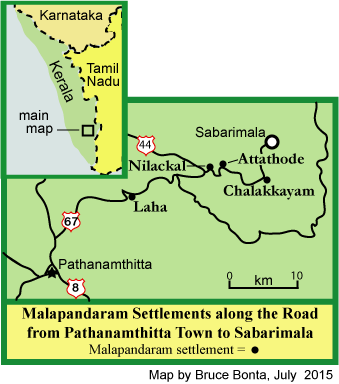A new primary school in Kerala that opened in June to much fanfare for Malapandaram kids, but which was threatened in July with closing due to insufficient funds, has been kept open after all.The Hindu reported last week that the school at Attathode, located on a major road to Sabarimala, was saved due to quick action in securing funds by a local official—the District Collector, S. Harikishore.
 Mr. Harikishore has been able to find the funding to ensure that the children attending the school are given three meals every day, one of the major issues reported last month. Another problem was that promises to provide daily transportation service to and from the school to the other nearby Malapandaram communities in the forest areas of Chalakkayam, Nilackal, and Laha had not been fulfilled.
Mr. Harikishore has been able to find the funding to ensure that the children attending the school are given three meals every day, one of the major issues reported last month. Another problem was that promises to provide daily transportation service to and from the school to the other nearby Malapandaram communities in the forest areas of Chalakkayam, Nilackal, and Laha had not been fulfilled.
The District Collector was able to arrange for money to pay for a driver to transport the children. He used Kerala funds from the Gothra Sarathi scheme, launched by the state in 2013 to provide transportation for tribal children so they could attend schools.
The article in The Hindu announcing this development also reported that the school has been given a laptop computer, pictured in the report with numerous Malapandaram children and some adults gathered around it. The gift was presented by an Indian from a nearby community who has settled in Houston named Reji Kurien.
The children watched some PowerPoint presentations and some short films. The laptop has been loaded with education software and it will be used to expose the children to the digital age. Mr. Kurien was accompanied by the Member of the Legislative Assembly, Raju Abraham, and other officials in a presentation at the school on Tuesday last week.
Another article in The Hindu described the outreaching efforts of the District Collector, Mr. Harikishore, to get to know the tribal settlements of Pathanamthitta District, many of which are Malapandaram. He is the chief administrative official of a district of about 1.2 million people. He has initiated a program he is calling “A day in a tribal hamlet,” in which he travels with a couple other officials to each of the hamlets in turn and listens to what the people have to say.
He told the reporter he is finding that the young people are eager to leave the forests and move into settled communities, as are many women if they are given shelters, food, water, and the necessary clothing. He has found that malnutrition is a serious problem among the tribal people. A majority of the women and children turned out to be anemic, and they tend to use salt excessively, which elevates their blood pressure.
The Malapandaram families at Chalakkayam, near Sabarimala, had several requests for Mr. Harikishore: they asked for sheets for their beds, food grains, and plastic sheets in order to cover the roofs of their huts. That request prompts the reader to wonder what their living conditions are really like—why the plastic sheeting? Brian Morris’ book about the Malapandaram, Forest Traders(1982a), provides some insight into their physical living conditions.
Morris distinguished between the temporary forest camps occupied by one to four nuclear families and the larger settlements, places allotted to the people by the Forest Department for semi-permanent dwellings. The people living in those settlements tended to make day trips into the nearby forests for food and supplies.
He described the Paranthadi settlement, located on the northern bank of the Achencoil River. It consisted of around 10 huts made of grass thatching, though the number varied depending on the individuals and families coming and going. About six families were normally associated with the settlement. The huts were constructed in various ways, but the most substantial of them were quite simple.
The hut of a man named Daniskody, who referred to himself as the headman (though he had very little authority when Morris was there) was the largest of all. The anthropologist described that hut as rectangular, built with nine upright support posts and a framework of other poles that held up a roof thatched with grass. The hut faced the river and was open on two sides, with the northern side slatted with bamboo strips in an attempt to keep out the rain.
Other huts that Morris described were smaller but constructed essentially the same way—mostly covered with grass thatching. In some other settlements, huts were thatched with bamboo leaves, though he indicated that some of the older settlements had more permanent structures.
His summary of the forest settlement huts appears to still be accurate: “Hill Pandaram huts are in general much smaller, and often flimsily made; they are frequently open on at least one side, and very often … they are not enclosed at all and are essentially only roof shelters (p.58).” It is no wonder that the Malapandaram at Chalakkayam requested plastic sheeting—to provide better protection from the rain than their traditional structures did.